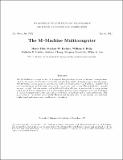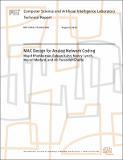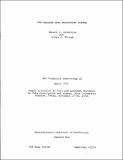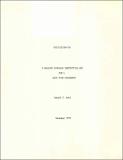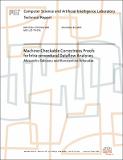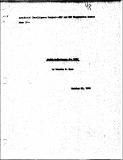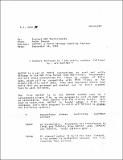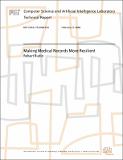Browsing Computer Science and Artificial Intelligence Lab (CSAIL) by Title
Now showing items 1929-1948 of 3804
-
M&M: A Passive Toolkit for Measuring, Correlating, and Tracking Path Characteristics
(2004-04-14)This paper presents M&M, a passive measurement toolkitsuitable for large-scale studies of Internet path characteristics.The multiQ tool uses equally-spaced mode gaps in TCP flowsÂ’packet interarrival time distributions to ... -
The M-Machine Multicomputer
(1995-03-01)The M-Machine is an experimental multicomputer being developed to test architectural concepts motivated by the constraints of modern semiconductor technology and the demands of programming systems. The M- Machine computing ... -
MAC Design for Analog Network Coding
(2010-08-02)Most medium access control mechanisms discard collided packets and consider interference harmful. Recent work on Analog Network Coding (ANC) suggests a different approach, in which multiple interfering transmissions are ... -
MAC PDP-6 DECtape File Structure
(1965-07-01)The MAC system programs, MACDMP, TECO, and MIDAS, assume a certain data structure on DECtapes which they handle. Each DECtape has 1100 blocks of 200 words, numbered 0 through 1077. Block 0 and blocks 1070 through 1077 are ... -
The MAC System: A Progress Report
(1964-10)The notion of machine-aided cognition implies an intimate collaboration between a human user and a computer in a real-time dialogue on the solution of a problem, in which the two parties contribute their best capabilities. ... -
The Macaims Data Management System
(1971-04)MacAIMS (MAC Advanced Interactive Management System) is a relatively small research project that was initiated in the summer of 1968 to investigate the feasibility of using some of the then existing computer facilities at ... -
MACE: A Multiprocessing Approach to Circuit Extraction
(1986-10)The ever-increasing complexity of VLSI chips threaten to choke out all available computer power unless methods are devised to keep the CAD tasks conveniently sized. A review of the current methods of multiprocessing ... -
A Machine Architecture to Support an Object-Oriented Language
(1979-03)In object-oriented languages (e.g., LISP, Simula, and CLU), all (or most) data objects used by a program are implicitly allocated from a free-storage area and are accessed via fixed-size references. The storage for an ... -
A Machine Language Instruction Set for a Data Flow Processor
(1979-12)A data flow processor is a computer in which instructions are data driven and enabled for execution by the arrival of their operands. Data flow processors execute data flow programs, normally represented as program graphs, ... -
Machine Recognition as Representation and Search
(1989-12-01)Generality, representation, and control have been the central issues in machine recognition. Model-based recognition is the search for consistent matches of the model and image features. We present a comparative ... -
Machine-Checkable Correctness Proofs forIntra-procedural Dataflow Analyses
(2004-12-16)This technical report describes our experience using the interactive theorem proverAthena for proving the correctness of abstract interpretation-based dataflow analyses.For each analysis, our methodology requires the ... -
Maclisp Extensions
(1981-07)This document describes a common subset of selected facilities available in Maclisp and its derivatives: PDP-10 and Multics Maclisp., List Machine Lisp (Zetalisp), and NIL. The object of this document is to aid people in ... -
MACRO Definitions for LISP
(1963-10-01)In LISP 1.5 special forms are used for three logically separate purposes: a) to reach the alist, b) to allow functions to have an indefinite number of arguments, and c) to keep arguments from being evaluated. New LISP ... -
MACTAP: A PDP-6 DECtape Handling Package
(1965-09-01)MACTAP is a set of PDP-6 subroutines to read and write DECtape in the MAC file format (see MAC-M-249). Programmers can call these subroutines for input or output of ASCII data, which will be compatible with TECO files; or ... -
Making Aesthetic Choices
(1979-03-01)A framework is presented for making choices that are primarily constrained by aesthetic, as opposed to, pragmatic considerations. An example of the application of this framework is a computer system called "Ani", capable ... -
Making Medical Records More Resilient
(2008-02-17)Hurricane Katrina showed that the current methods for handling medicalrecords are minimally resilient to large scale disasters. This research presents a preliminary model for measuring the resilience of medical records ... -
The Making of the Film, SOLAR CORONA
(1973-02-01)The film SOLAR CORONA was made from data taken from August 14, 1969 through May 7, 1970, by OSO-VI, one of the Orbiting Satellite Observatories. One of the experiments on board scanned across and up and down the image of ... -
MAM: A Semi-automatic Debugging Tool for Distrubuted Programs
(1987-06)Traditional debuggers, designed to examine single process serial programs, do not provide sufficient functionality for efficient debugging of distributed programs. There are a number of fundamental differences in the way ... -
Management of Object Histories in the Swallow Repository
(1980-08)SWALLOW is an experimental distributed data storage system that provides personal computers with a uniform interface to their local data and the data stored in shared remote servers called repositories. The SWALLOW ... -
A Manager for Named, Permanent Objects
(1980-04)Storing data in a computing system for a long time has been of interest ever since it was possible to do so. Classically, on stores bit- or byte- strings, or perhaps arrays of "records." Yet, current programming philosophy ...

